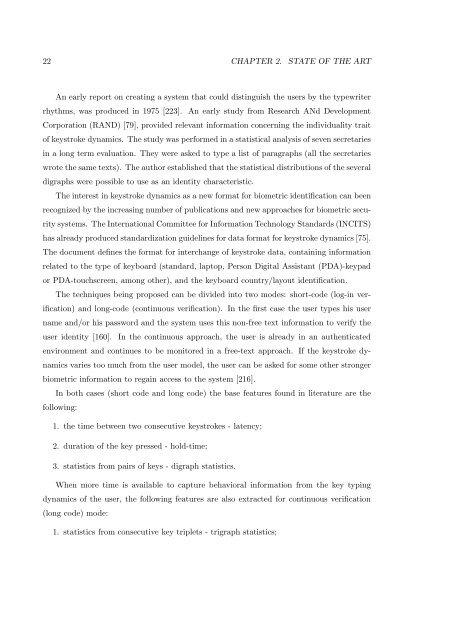Thesis - Instituto de Telecomunicações
Thesis - Instituto de Telecomunicações
Thesis - Instituto de Telecomunicações
Create successful ePaper yourself
Turn your PDF publications into a flip-book with our unique Google optimized e-Paper software.
22 CHAPTER 2. STATE OF THE ARTAn early report on creating a system that could distinguish the users by the typewriterrhythms, was produced in 1975 [223]. An early study from Research ANd DevelopmentCorporation (RAND) [79], provi<strong>de</strong>d relevant information concerning the individuality traitof keystroke dynamics. The study was performed in a statistical analysis of seven secretariesin a long term evaluation. They were asked to type a list of paragraphs (all the secretarieswrote the same texts). The author established that the statistical distributions of the severaldigraphs were possible to use as an i<strong>de</strong>ntity characteristic.The interest in keystroke dynamics as a new format for biometric i<strong>de</strong>ntification can beenrecognized by the increasing number of publications and new approaches for biometric securitysystems. The International Committee for Information Technology Standards (INCITS)has already produced standardization gui<strong>de</strong>lines for data format for keystroke dynamics [75].The document <strong>de</strong>fines the format for interchange of keystroke data, containing informationrelated to the type of keyboard (standard, laptop, Person Digital Assistant (PDA)-keypador PDA-touchscreen, among other), and the keyboard country/layout i<strong>de</strong>ntification.The techniques being proposed can be divi<strong>de</strong>d into two mo<strong>de</strong>s: short-co<strong>de</strong> (log-in verification)and long-co<strong>de</strong> (continuous verification). In the first case the user types his username and/or his password and the system uses this non-free text information to verify theuser i<strong>de</strong>ntity [160]. In the continuous approach, the user is already in an authenticate<strong>de</strong>nvironment and continues to be monitored in a free-text approach. If the keystroke dynamicsvaries too much from the user mo<strong>de</strong>l, the user can be asked for some other strongerbiometric information to regain access to the system [216].In both cases (short co<strong>de</strong> and long co<strong>de</strong>) the base features found in literature are thefollowing:1. the time between two consecutive keystrokes - latency;2. duration of the key pressed - hold-time;3. statistics from pairs of keys - digraph statistics.When more time is available to capture behavioral information from the key typingdynamics of the user, the following features are also extracted for continuous verification(long co<strong>de</strong>) mo<strong>de</strong>:1. statistics from consecutive key triplets - trigraph statistics;
















